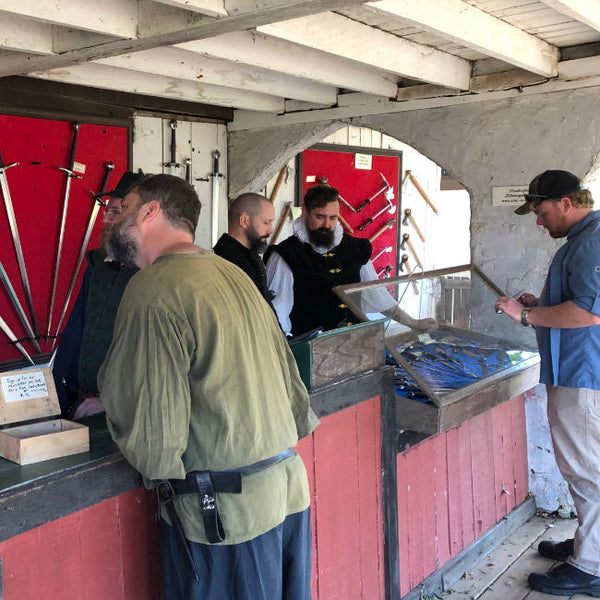We are back to doing shows with customers, at least for the present, fingers crossed. We have done renaissance fairs for over 40 years now and it seemed strange not be there last year. We have a bit of a training system for folks who help us in our booth. Over the years we have evolved a list of the most asked questions or statements by our visitors. As the general public does not always have a depth of knowledge in the area of historic arms and armor, we get a range of topics and questions that we answer quite often.
So, while our blog readers almost certainly know the answers to these, it is good to remember that when sharing our love of history, dispelling the misinformation in popular thought is a noble mission. That’s at least what we tell ourselves to stay sane :-). While our main job is to make replica weapons and sell them, we often find that sharing the truth about these pieces and the history around them is definitely a major element of what we do. With the visitors of the renaissance fairs, we get to do that with a broad spectrum of the general public.

Helping patrons at the MN Ren Fair
Most asked questions of the Renaissance
- Are these real?
Variations: Do these work? Are these sharp? Usually in reference to the weapons and with the implication that they are either antique original or that they are somehow made just to be decorative.
Suggested Response: They are fully functional working replicas. They are designed to do everything the original would do. We strive to replicate the originals in form as well as function.
- Can you imagine ...?
Variations: Too many to count, they include: being cut/stabbed/chopped/hit/stapled, killed, fighting, wearing that all day, and many many more.
Suggested Response: Yes. No. Use your imagination.
- Are these balanced for throwing? Normally asked about the daggers, though the axes are sometimes mentioned.
Responses: Any object has a center of gravity which it will spin around if thrown with rotation. This usually corresponds to the balance point. The skill of throwing any type of weapon this way is to gauge the revolutions needed to cover the distance from you to the target. This is quite easy, with a little practice, for hand axes (our Viking axes) and certain daggers designed for the purpose. These daggers are usually of one piece construction and not equipped with cross guards and pommels as these add undo stress to the dagger when it is impacting with a target.
4. Is this folded, Damascus or layered? In reference to any of the steel parts usually the blades.
Variations: Damascus steel can cut through regular steel blades, “Is this steel folded 10,000 times? I usually only use blades with 10,000 layers”
Responses: Layering steel is techniques used by ancient metal manufacturers to incorporate inferior steel and iron into their product and still have a workable item. The folded and cable welded blades were produced in Northern Europe and the Orient while Wootz (often referred to as Damascus) actually came from Central Asia and India and is smelted in a pot. This leaves high levels of carbon infused into softer body of material with dendrite inclusions.
- Have you seen ...?
Variations: movies, weapons, books, anything with weapons, armor, and fighting involved. It is usually followed by how much would one of those cost?
Responses: It will be difficult to answer and fill in the picture they have created in their mind of what they see as the reality of swords, fighting, weapons and armor. Most often it’s a prelude to them telling you their deep insight into the topic they have broached. It is best to let them have as much information as they are open to. If they begin to argue always query about the source of their interesting information but don’t waste too much time arguing, other customers need your attention. Best to excuse yourself and leave them to their own thoughts.
- Which one of these would you choose to fight with?
Variations: They are after the eternal question of what is the best sword/weapon.
Responses: There is no best sword/weapon. If there was everyone would use that one. Personal preference and tradition play the biggest factor in what one chooses. That is about it. A person would pick the weapon they are most comfortable with or was to hand in an emergency. Several Masters of defense from the Elizabethan age commented that the Staff was one of the best all-around weapons.
- Is this stainless?
Variations: See Q4 above
Responses: We chose our materials to provide the durability and strength the current market demands in replicas. These are quite a bit different than what was available to the craftsman of the period. We strive to replicate a great quality blade of the period as opposed to a super sword using modern technology.
- Is this felt? In reference to the grips, but the most common is I need a big grip as I have big hands.
Responses: Our grips are covered with a durable leather that is glued to a hard wood base. The wire wrapped grips are steel wire twisted and wrapped around a core.
Dagger display at Arms & Armor Inc.
9. Mail stopped arrows. Mail armor is effective against the slice of a blade, but is not very good at chopping blows and almost ineffective against thrusts or punctures from arrows.
Responses: Check out our recent blog posts :-) here and here. Mail is excellent at the avoidance of a cut and can be surprising resilient to punctures but when a heavy impact occurs with blunt force trauma it can allow some intense injuries.
- Knights cannot get up if they fall on their backs.
Responses: This is totally false, a knight in armor for battle was very mobile. If he wasn’t, he would be susceptible to attacks from behind or from an unarmored opponent. In fact, it is recorded that some knights were able to leap into their saddles from a standing position beside their horse. Now if you are in armor and have been fighting for an hour and the battlefield has turned to sticky mud and you fall or are trampled down it can turn into a serious situation, just ask the French at Agincourt.
- “Those grooves in the blade are for blood to flow out of the wound faster, also they keep a blade from sticking in the body due to suction.”
This is usually stated to their companions as opposed to telling us, but there have been some that have told us this as if we would not be aware of this tried-and-true wives’ tale fallacy.
Responses: It is, of course, a reference to the fullers that are forged or ground in some blades. These were created to conserve steel and reinforce edges. Using a fuller in a blade allows less metal than a diamond cross sectioned blade for the same profile in some cases. It also strengthens the blade in the plane of the edges on the same principle as the I-beam. It has absolutely no ability to increase blood flow from the wound and the only way to get a weapon stuck in a human body is to jam it between bones of sufficient size to lodge the weapon.
- “Triangular blades causes unhealable, sucking wounds. “
Response: This is another falsehood that permeates the study of weapons. A spike like blade causes a puncture wound. These can be deadly as even a 3” deep wound can be fatal in areas of the body. But there really is nothing that qualifies as a sucking wound. If a lung is penetrated, you may get some air exchange through the puncture when the victim breathes. As far as it being a wound that will not heal that again is not true and it needs to be noted that no wounds heal if you die before it has a chance to heal.
- Is that a Welsh Claymore/Scottish Cleaver/Armor Cracker/Raapppeeeaar (rapier) /and so on and so on.?
Responses: You will hear about 10 million convoluted names from the patrons, very few if any are even remotely historical. Sometimes they can be beyond semi understandable. We strive to suggest a polite answer that identifies the piece they are looking at or describing with an authentic term. When they contradict, we will usually just nod and say ok. There is always another customer to focus our service and attention on.
Scottish Longsword by Arms & Armor Inc.
We enjoy our experiences at the fairs selling to the patrons who visit. We always strive to provide clear and informative experience for our visitors. The challenge is to help those folks who are more concerned about telling us what they know about our products and possibly may not have the best resources to rely on.
We hope to see you at the show or when you are able to visit the shop and look forward to making you a great piece from Arms & Armor Inc.
Note: these questions we hear often but they are not weapon or armor related, but they are still classic Ren Faire comments.
Absolute most asked of all time - Where are the bathrooms?
Is that fire real?
Is this sharp? As the run their thumb along the edge and then ask for a bandage.
How do all these booths breakdown and get moved to the next show?
Do you live here all year long?
Why do you talk like that? Usually when we are not using an accent.
I can get that for half the price on the shopping network.
Where’s the party after this? Note: Usually, we all get some food and go find a place with real porcelain fixtures.

Nathan Clough, Ph.D. is Vice President of Arms and Armor and a member of the governing board of The Oakeshott Institute. He is a historical martial artist and a former university professor of cultural geography. He has given presentations on historical arms at events including Longpoint and Combatcon, and presented scholarly papers at, among others, The International Congress on Medieval Studies.
Craig Johnson is the Production Manager of Arms and Armor and Secretary of The Oakeshott Institute. He has taught and published on the history of arms, armor and western martial arts for over 30 years. He has lectured at several schools and Universities, WMAW, HEMAC, 4W, and ICMS at Kalamazoo. His experiences include iron smelting, jousting, theatrical combat instruction and choreography, historical research, European martial arts and crafting weapons and armor since 1985





